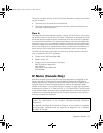
C-6 Dell PowerEdge 4350 Systems Users Guide
&RUURVLRQ
The oil from a persons fingers or prolonged exposure to high temperature or humidity
can corrode the gold-plated edge connectors and pin connectors on various devices in
the system. This corrosion on system connectors is a gradual process that can even-
tually lead to intermittent failures of electrical circuits.
To prevent corrosion, you should avoid touching contacts on boards and cards. Pro-
tecting the system from corrosive elements is especially important in moist and salty
environments, which tend to promote corrosion. Also, as a further deterrent to corro-
sion, the system should not be used in extreme temperatures, as explained in
Temperature found earlier in this appendix.
(6'
ESD results from the buildup of static electricity on the human body and certain other
objects. This static electricity is often produced by simple movements such as walk-
ing across a carpet. ESD is a discharge of a static electrical charge, that occurs when
a person whose body contains such a charge touches a component in the system.
This static discharge can cause components, especially chips, to fail. ESD is a prob-
lem particularly in dry environments where the relative humidity is below 50 percent.
To reduce the effects of ESD, you should observe the following guidelines:
When working inside the system, wear a wrist grounding strap. If a wrist ground-
ing strap is unavailable, touch an unpainted metal surface on the chassis
periodically to neutralize any static charge.
If at all possible, stand on a concrete floor while working inside the system.
Use an antistatic floor mat when working inside the system.
If it is necessary to work in a carpeted area, spray the carpet with an antistatic
spray and allow it to dry before beginning to work inside the system.
Keep components in their antistatic packaging until they are installed.
Avoid wearing clothing made of wool or synthetic materials.
(OHFWURPDJQHWLFDQG5DGLR)UHTXHQF\,QWHUIHUHQFH
Electromagnetic interference (EMI) and radio frequency interference (RFI) from a sys-
tem can adversely affect devices such as radio and television (TV) receivers operating
near the system. Radio frequencies emanating from a system can also interfere with
cordless and low-power telephones. Conversely, RFI from high-power telephones can
cause spurious characters to appear on the systems monitor screen.
RFI is defined as any EMI with a frequency above 10 kilohertz (kHz). This type of inter-
ference can travel from the system to other devices through the alternating current
(AC) power cable and power source or through the air like transmitted radio waves.
The Federal Communications Commission (FCC) publishes specific regulations to
limit the amount of EMI and RFI emitted by computing equipment. Each Dell system
meets these FCC regulations.
3502Ebk0.book Page 6 Friday, November 13, 1998 10:00 AM


















